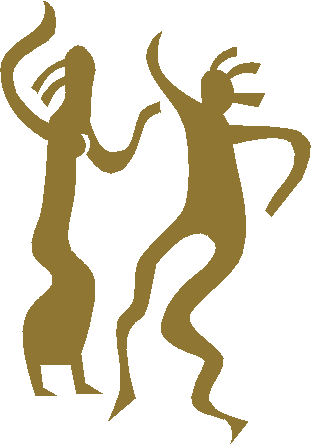| IMAGE
DOES MATTER  In what ever you
do, and whatever we say, we convey a picture of who we are. When we talk, we have the
opportunity to explain who we are, how we feel, and how we think. When we dance, we
project an image in mime, communicating not in words, but through movement. In what ever you
do, and whatever we say, we convey a picture of who we are. When we talk, we have the
opportunity to explain who we are, how we feel, and how we think. When we dance, we
project an image in mime, communicating not in words, but through movement.
What image does your dancing
project? The image should be one that conveys the feeling of the dance, and still have the
essence of the dancer.
BODY LANGUAGE
With so much emphasis on body
language today, it pays to be aware of the image we wish to project. Always think
“up”. Even in the dances that settle in the knees, the solar plexus
should be lifted with an elegance that tells the world that you are a worthwhile
individual. It is also easier to breathe and less tiring.
FOOTWORK
Footwork is very important in
the projection of the overall image. Toe out too far (a problem of many ballet dancers)
and you resemble Charlie Chaplin. It takes on a comical look and throws the body out of
line. Toe in and the look is one of weakness. (Character actors will “toe in” to
add authenticity to a weak character). Classic footwork is best achieved by adhering to
the basic foot positions.
Check that the soles of your
shoes are worn evenly. If they are worn down on the outside of the foot, your weight is
rolling to the outside and will produce a club-footed look. It also has an unsteady
“feel” and can be corrected by gaining control of the entire foot. Loose feet
project an awkward image.
For ladies, in particular,
backward steps can project an awkward look. Make sure that one foot goes directly behind
the other. “Double tracking”, with the feet apart, is only good for comedy
roles. Allow your knees to brush lightly against each other as one foot passes the other.
Keep the shoulders up and carefully place one foot behind the other as you travel
backward. Think of one straight line and step on it.
ARM MOVEMENTS
Arm movements should enhance the
dance by adding line and symmetry. Exaggerated arm movements, as well as fingers are for
performance, and even then should be used with caution. Determine the desired picture,
then practice in front of a mirror. What does your image say?
In each dance, carefully study
the mood and the general characteristics of the dance. Try not to let one style dominate
and carry over into all of the other dances. We all know of people who “Waltz”
their Foxtrot, or who “Boogie” their Cha Cha Cha. Dancing is far more fun when
the feelings of the dance are separated and interpreted.
Project Happiness. Smile when
you dance. Laugh if the opportunity presents itself. Don’t be afraid to enjoy the
dance. Nothing destroys the dance so much as someone looking as though the whole thing was
either hard work or, worse yet, boring.
Project Confidence. Know your
patterns so well that variations flow with ease. Dance only the material that you can
dance with confidence. Save the new and hard material for practice sessions.
Remember that we are talking
non-verbally when we dance. We tell more about ourselves than we realize. And beyond
that, we can become that which we project, by first feeling the part, and then projecting
that image in the dance.
Efficient body carriage is the
basis of graceful and attractive dance movement. Good posture is natural, functional and
comfortable. One should stand with the body weight (CPB) directly over the sole foot, with
the knees slightly flexed. The chest is held slightly forward and the shoulders are wide.
The head is directly over the chest, held high, with the chin parallel to the floor.
The entire appearance of the
body is “easy but erect”, and it should be possible to draw a straight line
through the ear lobe, the outer tip of the shoulder, the center of the hip, the knee, and
ankle. Feet are held together in 1st position, and body alignment should be
symmetrical.
Common faults in body posture
are side swaying of the body, drooping shoulders, dropped chin, or slumping chest. These
should be avoided.
Effective posture and a strong
sense of balance, both in a static or moving position, assure the body control that
underlies all dance movement. 
|
